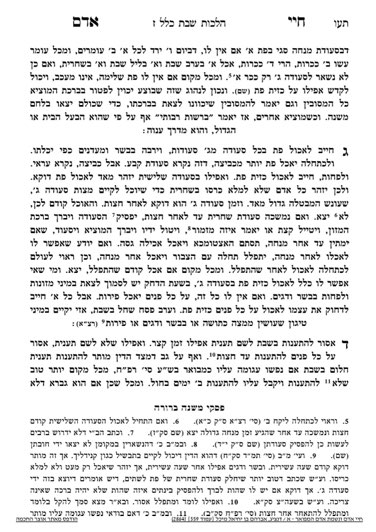The current series, which will cover seudos Shabbos and fasting on Shabbos, is available for sponsorship. Please contact Rabbi Reingold for more information.
We are continuing siman 3, discussing the halachos of seudah shlishis, also commonly known as shalosh seudos. The Chayei Adam writes that the time for seudah shlishis is after chatzos, and if one eats seudah shlishis before chatzos, they are not yotzei. The only exception is when erev Pesach falls out on Shabbos, where there are limited options as to what one may eat after chatzos, so there is a singular opinion which holds one may be yotzei seudah shlishis before chatzos. People rely on this shita since one will anyways have to rely on a less than optimal opinion, given the nature of the conflict between erev Pesach and seuda shlishis.
Other than erev Pesach, if one eats shalosh seudos before chatzos, they are not yotzei, and must eat again.
If a person ate the second seudah early in the day, and then begins shalosh seudos before chatzos but continues the meal until after chatzos, they can be yotzei provided they ate a k’beiah (or minimally a kezayis) after chatzos. However, if they did not eat earlier in the day and started the meal before chatzos and continued afterwards, they cannot consider the fact that the meal began before chatzos and ended after chatzos as though it were two meals. They may interrupt their meal with birchas hamazon and then wash again. Since Chazal say that once the stomach is open, it is easier to put more food into it, so it would make sense that one would want to continue eating immediately rather than eat the seudah shlishis later.
However, we have to understand how it is muttar to recite birchas hamazon and immediately wash again, as it would seem to be that all of the extra brachos recited for birchas hamazon, re-washing and hamotzi are unnecessary. Even if it is not a bracha levatalah, it is still considered a bracha she’eina tzricha. For example, if one walks into the kitchen before a hamotzi meal and sees french fries, and wishes to taste a few, their wife is correct in saying “just wait for the meal!”, when all of the brachos will be subsumed under hamotzi and therefore any additional bracha will be a bracha she’eina tzricha.
Therefore, the Chayei Adam writes that before washing again for seuda shlishis, one should take a walk, daven or do other things to make an interruption. The MIshnah Berurah writes that if one remains seated at the table, it is considered one long meal, and the birchas hamazon becomes a bracha she’eina tzricha. There are opinions which hold that one should create a significant interruption, with some opinions holding 30 minutes and some holding 15 minutes. People should walk away from the table, change the cutlery, and make other indications that it is a new meal.
The Chayei Adam writes that this possibility of eating the two seudos in quick succession is actually recommended for some individuals because if one takes a significant break and their stomach closes, it may be an achila gasah (forced eating beyond what is normal) to eat seuda shlishis later. But, if one knows that they will be able to eat a proper seuda shlishis later in the day, they should finish their daytime seudah, daven mincha, and eat seuda shlishis later.
Summary
One cannot eat seuda shlishis before chatzos, except possibly on erev Pesach which falls out on Shabbos.
If one begins seuda shlishis before chatzos and it finishes after chatzos, they may consider it seuda shlishis if they had a k’beiah (or minimally, a kezayis) of bread after chatzos.
If one will feel that they are overeating if they eat seuda shlishis later on, they can bench and re-wash in the middle of the meal, provided they take a break in between which clearly demarcates that the meals are separate.



